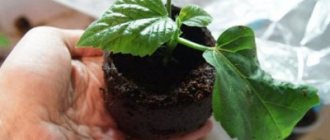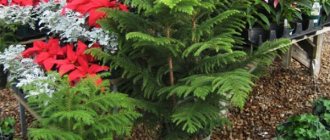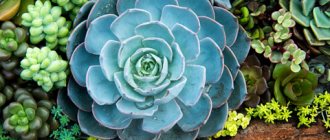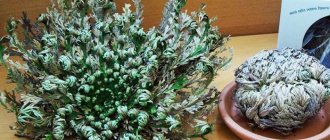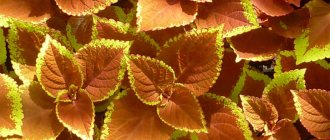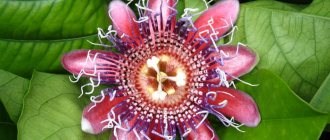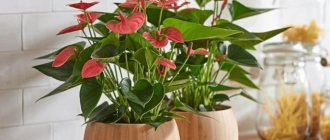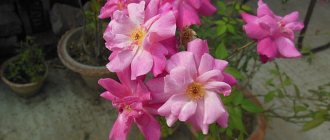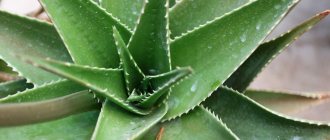Photo of Adenium flowering – succulent beautifully flowering shrub from the Kutrovaceae family. In its natural environment, it is distributed in the arid regions of Southern and Central Africa. The homeland of adenium is the Arabian Peninsula. The perennial decorative deciduous succulent is distinguished by a light gray trunk, thickened at the bottom.
In nature it grows up to 3.5 m, forming long branches. The length of large glossy leaves can reach 45 cm. The height of a tree grown indoors does not exceed 0.5 m. Homemade adenium is in no hurry to grow. By the age of three, its height reaches only 0.25 m.
At the age of four, the plant already blooms with spectacular flowers reminiscent of roses. For its resemblance to the queen of flowers, the shrub is often called the desert rose.
Also be sure to look at the catharanthus flower from the same family Kutrovaceae.
| Growth rate is low. |
| At the age of four, the plant already blooms from late spring to autumn. |
| The plant is easy to grow. |
| It is a perennial plant. |
Types and varieties of adenium: photos and descriptions of some varieties
The plant belongs to the Arosupaceae (Kutrovaceae) family.
There are about 50 different varieties of adenium, with some differences in the appearance and overall development of the plant. However, not all types of adenium are used for domestic cultivation, and most of them remain exclusively wild plants. Below is a description of some of them.
Adenium crispum
This plant can be distinguished by its very unusual oblong and very narrow leaves. Each leaf of this species has a wavy surface, especially noticeable at the edges of the leaf body. The stem thickening is mostly located underground, which is also not entirely common for representatives of this genus.
The photo shows that this type of adenium has very original inflorescences, the base of which is painted yellow-white, and the edges of the petals are a very rich crimson color:
In the center of each petal you can see several longitudinal stripes of the same color as the outer part of the flower.
Adenium multiflora or multiflorum
Among the varieties of adenium, this one is distinguished by its shape, which is more akin to a shrub than to a tree-like plant. This feature is due to the large number of thin, very highly branched shoots.
This species begins to bloom at the beginning of winter and is distinguished by a large number of inflorescences. Each flower has a diameter of about 5 - 7 cm. The border of the petals is painted in a very bright dark crimson color, the base is white.
Adenium obesum or obese
This species differs in many ways from most of its other brethren. The base of the trunk of this species is about 1 m wide, and is much thicker than the two previous trees.
Branching begins at the very top of the trunk. The leaves are leathery, gray-green in color and quite sparsely scattered throughout the crown. The length of each individual leaf is usually no more than 10 cm.
In total, this species reaches approximately 1.5 m in height. This plant blooms preferably in summer. The inflorescences are small, each individual flower reaches 4–6 cm in diameter.
Adenium Mini Size
As you can see from the photo, this variety of adenium is ideally suited for growing indoors - its height is only 12 - 17 cm.
Adenium arabic
A feature of this species is the ability to grow up to 4 m in height. The species is also distinguished by the largest leaves in the genus - sometimes they reach up to 20 cm in length and 12 cm in width. True, this happens in the case of ideal climatic conditions. In a less favorable environment, this species becomes a low shrub plant.
Most of its thickened base goes almost completely underground, and the branching begins quite low. Arabic adenium blooms in early spring, after awakening from hibernation. However, individual flowers may appear sporadically throughout the year. The color of the flowers is bright pink.
Adenium swazicum
Another type of shrub-like adenium. The photo shows that the home adenium flower is no more than 30 cm tall, but taller specimens are also bred through selection (up to 65 cm):
From the thickening of this plant several branches grow, forming a wide crown at their ends. The stems may hang over the pot as they usually grow somewhat horizontally.
The tree does not hibernate and, with proper care, remains evergreen. The flowers do not have the color transitions characteristic of adenium and are completely colored in one tone (usually light pink).
The tree is native to countries such as South Arabia, Uganda, Kenya, and Tanzania. In its homeland, when developing in a tree’s natural environment, it can reach 3 m in height. At the same time, when caring for adenium at home, it will not be possible to obtain a height greater than 50–60 cm, since it is very difficult to bring the plant’s living conditions closer to natural ones.
Description of the genus of succulents Adenia
Representatives of the genus Adenia are found throughout East and West Africa and Southeast Asia. The greatest diversity of species can be found in Madagascar. This genus has about 100 species and is generally poorly studied.
Adenia is by far the second largest genus in the family Passifloraceae (Passion Flowers). Due to the fact that this genus has been little studied, confusion often arises in the description and classification of this strange group. Adenia covers the entire spectrum of diversity of forms, from trees to vines and even tuberous herbs. Even within individual species, the appearance of these plants can vary widely depending on the conditions in which they grew. This makes it difficult to give a general description of all the varieties within the genus.
All Adenia are perennial crops. Some put all their energy into underground tubers, producing annual stems and leaves that die back each year. Others do not form tubers and instead store all their water and nutrients in thick stems (caudex forms). This property has made several Adenia species popular among succulent lovers around the world. It is always interesting to see a giant tail-shaped trunk (in some species the caudex can reach up to 2.5 meters) with tufts of spindle-shaped stems.
Succulent varieties are represented by caudex forms. The caudex of Adenia can be underground (A. kirkii or Adenia repanda) or aboveground (Adenia spinosa, A. glauca, etc.). All Adenia have liana-like stems equipped with tendrils.
All species of the genus are dioecious - individual plants are either male or female. Some species have very short flowering seasons. Most of them bloom just before the start of the rainy season and by this time are completely leafless.
Most Adenia are extremely poisonous. This feature was developed by the conditions in which these plants, which were often eaten by herbivores, developed. To protect themselves, Adenia, in the course of evolution, began to produce toxic compounds - lectins. These proteins cause a variety of problems in animals, including rapid cell death, blood clotting, and disruption of DNA function. Because of this, animals stopped eating Adenia, which in turn gave her a chance to survive.
When you are going to carry out any procedures with a succulent (transplantation or pruning), remember the toxicity and try to protect yourself.
How to stimulate adenium flowering: location and temperature
Growing and caring for adenium at home is not a very painstaking task, but still requires some attention, since this plant is not accustomed to being in temperate latitudes. In order for a flower to grow and develop properly, it is important to take into account factors such as the location of the plant, watering and fertilization, temperature and many others.
It is important to remember that caring for an adenium flower at home requires some care, since the natural development environment of this plant is quite specific. It is better to choose a warm place for the tree, with bright sunlight. In winter, perhaps a less bright place.
In summer you can put it outdoors, in a sunny, wind-protected place. Interestingly, what kind of lighting the plant needs directly depends on the air temperature in the room where the flower grows. The warmer the room, the more light the tree needs, and vice versa.
The optimal lighting time for adenium is 12 hours. This is especially true for those times of year when the heating is turned on in the house and because of this the plant requires a lot of light. For this reason, artificial lighting may be required in winter.
However, this also has its own characteristics - the daylight hours for this flower should not exceed 14 hours. It is also worth keeping an eye on this in the summer, when the daylight hours are 16 hours long. In this case, at the end of the day, it is better to take the pot of adenium into a darker room.
Using the above knowledge, you can stimulate the flowering of adenium, since it directly depends on the habitat of the tree. Typically, most varieties begin to bloom with maximum light and a warm room.
A positive feature of a plant such as adenium is that, with proper watering, it is quite unpretentious to the temperature it stays in. In its native subtropical and tropical climate, the plant can easily tolerate temperatures of 42°C and above, which is due to sufficient air humidity.
However, in such conditions, the inflorescences wither much faster. In summer, the optimal temperature for adenium fluctuates around 30-35°C in combination with moderate humidity.
At temperatures above 38°C and below 16-20°, the plant slows down or even stops growing. In winter, the optimal temperature ranges around 12 - 15 °C. Such wintering conditions will help the tree to rest well, as a result of which in summer or spring (depending on the variety) the adenium will begin to bloom profusely.
Growing and care
Adenium loves warmth and sun - this should be taken into account when growing.
Selecting a location
A window sill located on the south or southeast side is well suited for adenium. The seedlings like sunny positions, but in particularly hot weather they can be moved further away from the window. Thanks to this, we will avoid leaf burns caused by intense sunlight. From autumn to early summer, potted flowers can withstand the sunniest weather.
The plant grows well outdoors. Such cultivation is possible only in summer, because the flower does not like too low temperatures. Adeniums grow best at temperatures between 20 and 30 °C. Growing in cool rooms is not a good idea. These types of potted flowers do not tolerate temperatures below 10 °C, so you should not place them near entrance doors or opening windows in winter.
To successfully grow Adenium abesum, it is necessary to balance the temperature in the room as much as possible. Indoor flowers from the succulent family do not tolerate temperature changes very well. Young seedlings are especially sensitive to changes.
Watering
Caring for adenium involves regular moderate watering. Formed like a bonsai, the flower reacts poorly to moisture errors. Proper care includes watering only after the substrate has completely dried. This allows the succulent to form a strong, thick caudex that stores water. Under natural conditions, the caudex accumulates water during cyclical periods of rain, which then allows it to survive drought. If the plant has constant access to water, the caudex will not grow properly.
Caring for adenium requires regular monitoring of the appearance of the caudex. As the substrate dries, the caudex becomes more and more sluggish. This is a signal that the bonsai substrate has dried out and the plant needs to be moistened.
It is worth emphasizing that adenium tolerates slight drying out much better than excessive watering.
The frequency of watering adenium should depend on:
- temperature;
- pot size;
- plant size.
Water and high humidity will not harm the plants as long as they are seedlings with the first pair of leaves. When real leaves appear, spraying should be stopped or reduced. Water combined with sun or strong lighting can cause burns. Adeniums grow better if you water them abundantly, but once a week (when the soil remains dry for 4-5 days).
Adeniums should not be overwatered - stagnation of water at the roots is fatal to the plant; the substrate must dry out before re-watering.
Since it is not easy to check the moisture content of the substrate before watering, you can stick a long bamboo toothpick into the pot in the evening all the way to the bottom. In the morning we check:
- if the toothpick turns dark, it means the substrate is wet;
- if it does not change color, the substrate is dry.
Skillful care of adenium at home will lead to rapid growth of the plant and the creation of a spectacular caudex on which shoots with flowers will grow. Water the plant directly in the saucer, avoiding soaking the above-ground parts.
So we water the plant until November, when the winter period begins.
In winter, we do not stop watering completely - lack of watering is harmful!
Fertilizer
For adenium, you should absolutely not use granular fertilizers that dissolve slowly - this can destroy the roots.
Adenium is fertilized with water-soluble fertilizers.
Nitrogen accelerates the growth of plants and green parts, phosphorus helps expand the root system, supports plant flowering, potassium stabilizes and catalyzes chemical processes in the plant, regulates the amount of other chemical components and water absorption. Only in the case of very poor soil are large doses of nitrogen applied during fertilization.
Most gardeners simply feed adenium with universal vermicompost or fertilizer for succulents, following the recommendations on the package. In the spring and summer, adenium is fed no more than once a month with fertilizers for cacti with a low nitrogen content. However, to increase the chances of flowering, you can use fertilizers for surfinia, no more than 2-3 waterings during the season.
Plants, especially young ones that are watered and supplied with nutrients more frequently during the growing season, grow quickly and tall, but their stems are not thick. Plants that are watered once a week and fertilized once a month grow shorter, but thicker and have denser leaves.
How to shape and trim?
Adenium can take the form of a bonsai. Beautiful shapes are achieved through appropriate pruning. When not grown in bonsai form, it is also necessary to prune the adenium at least once every 2 years to strengthen the caudex. Pruning is done in February-March, and not in autumn and winter.
After pruning, the plants are watered more often, with a higher dose of nutrients - they grow quickly, tall and slender.
If you water once a week (dry 4 days a week) and give less nutrients, they grow thicker, lower, but the leaves are denser.
To get a beautiful trunk, the plant needs to be dug up every 2 months. Not too much - about 3 cm up is enough. The thickness of the caudex depends on the “mother” plant. Whatever the mother plant is, the new one will be the same.
Attention! Adenium juice can cause irritation to the skin and gastrointestinal tract. Adenium should be kept out of the reach of children and pets, as it is very poisonous. When pruning, be careful, wash your tools thoroughly, and use gloves.
Some adeniums bush themselves, but they do it when they want. It is better to prune adenium at home at the age of 5-6 months. However, this procedure delays flowering. Picking off leaves and pruning is done to strengthen and thicken the caudex. By pruning adenium at least once every 2 years, we cause denser and more abundant flowering.
Graft
Since modern indoor adeniums are hybrids, you cannot independently obtain seeds that retain the properties of the mother plant. Therefore, grafting is used to quickly reproduce valuable specimens.
Adenium grafting step by step:
- An even cut is made on the rootstock using a sharp knife (preferably ceramic). Figure 1-3.
- Cut out a V-shaped wedge. Figure 4.5.
- 1 or 2 cuttings are cut from the propagated plant, most of the leaves are removed, and the lower end is cut into an even wedge. Figure 6.
- Scion cuttings are inserted into the rootstock. Figure 7.
- Wrap the graft tightly with plastic tape (tape can be cut from bags). Figure 8.9.
- A small plastic bag is placed on top to maintain high humidity. Figure 10. Periodically remove the bag and ventilate the graft. Adeniums grow together after about 3 weeks, the bag is removed, and the film is unwound.
Wintering
In indoor conditions, winter is a very difficult time for young adenium seedlings. Young seedlings require frequent watering provided they are kept at temperatures above +20 degrees and in a permeable substrate.
If in summer the plant should stand in a bright place with a temperature of about 20 °C, in winter the temperature cannot drop below 10 °C. At a temperature of + 15 °C, neither seedlings nor adult plants can be watered - then we will avoid wrinkling of the caudex.
If you provide a temperature of about 15 degrees in a sunny place and limit watering in winter to 2 times a month (in January and February only once), flowering in summer will be more abundant. No need to worry about fallen leaves while new ones are growing.
The beginning of spring is favorable for transplanting the plant into new soil and pruning.
When the leaves begin to fall in the fall (the dormant period is approaching), watering should be significantly reduced and resumed when the plants begin to produce new shoots in the spring (March).
Transfer
After transplanting, especially young plants, they are not fertilized for 2-3 months, because you can overdo it and simply burn them. The new soil contains all the necessary microelements.
Young plants or those in small pots should be replanted from a moist substrate. Then the root ball does not crumble (especially with small roots), and it is easier to remove the plant from the pot along with the roots. If we want to remove part of the soil around the roots or even trim the roots, then it is easier to replant “dry”.
Adenium does not need to be watered immediately after transplanting! Watering is carried out only when the soil is dry.
Reproduction
You can propagate adenium from cuttings at home. When transplanting, you can get cuttings from shoots.
How to root adenium cuttings - cut off part of the plant and place it in a jar of water. Once the cuttings are fully rooted, they can be placed in a substrate intended for succulents.
Another way to propagate adenium is by sowing seeds. However, the desert rose grows very slowly. It takes us several years to see the first flowers, but some plants sown from seed take even longer.
Problems during cultivation, diseases
When growing adenium, a number of problems may arise; you need to be able to recognize them and know how to deal with them:
- Yellowing leaves are a sign that the soil is too wet.
- During vigorous growth, the caudex should be hard and elastic, but it is not the woody part of the plant, so it will not be as hard as wood. The caudex should not be wrinkled, it becomes soft if it is watered too little or too much.
- If the caudex is soft and wrinkled, growth is slow - this is a sign of lack of water. We water when the caudex begins to wrinkle a little every few minutes, the next day the plant looks normal. In a critical situation, it helps to irrigate the top layer of the earth, and the caudex will become thick, hard, without a single “wrinkle”, as if by magic.
- A soft caudex can also be a sign of overwatering! After drying it becomes hard. If the caudex has become completely soft and wrinkled from overwatering, then the substrate must be replaced immediately.
- A slightly reddish leaf indicates sunburn.
- When plants are affected by disease, it is recommended to remove diseased leaves.
- When growing adenium, do not use any chemicals against spider mites and mealybugs - the plant can be irreversibly damaged by chemicals contained in pesticides.
- If you notice tiny webs and small worms on the undersides of leaves, it could be a spider mite. It is necessary to isolate the infected plant from the rest and collect the mite manually using a cotton pad, or carry out an environmental spray, for example, with garlic infusion (finely chop 4-5 cloves of garlic, pour in a liter of boiled water and leave for 3 days, after this time the drug is ready for use). spraying). If it doesn’t work, then use chemicals, but very carefully.
- If the adenium has dried out excessively, you can try throwing a film over the plant to increase humidity, periodically ventilating it for at least an hour. It comes to life after this coating and increased humidity.
- When the leaves fall, don’t panic, new ones will appear soon.
- If a plant begins to shed its leaves in late autumn (for no apparent reason), it enters a dormant period.
No flowering
Below are the most common reasons why adenium does not bloom:
- Desert rose may not bloom for several months, but if the plant is healthy and the growing conditions are right, it will eventually produce flowers. The plant begins to bloom from 2-4 years of age.
- Small plants should be shaded before flowering to avoid problems with budding.
- In order for adenium to bloom, you need to provide it with a period of rest and sufficient light during the growing season.
- Adenium does not bloom if it is filled with water.
- The plant does not like excessive fertilization with nitrogen; this can cause a lack of flowering.
- The plant does not like drafts and low temperatures (below 10 °C), such conditions have a bad effect on budding.
- The plant does not bloom unless pruned every 2 years. It is necessary to cut off the tips of the shoots in the spring, this stimulates flowering and tillering.
- If there is improper fertilization - lack of it or exceeding the dose of nitrogenous fertilizers - adenium does not bloom.
Reasons why adenium flowers fall off:
- too dry air and insufficient watering at high ambient temperatures (during adenium flowering, regardless of the temperature, you need to water a little more);
- the plant is exposed to drafts.
Substrate for indoor adenium flower at home (with photo)
It is worth remembering that there is no clear opinion on what the substrate for adenium should be. However, you can select several of the most popular recipes that promise healthy flower growth.
- Method 1 . This recipe was first used in Thailand. A small amount of pig droppings, wood compost, and pieces of coconut peel are added to 50% sticky clay. You can also add rice husks. But many gardeners warn that this amount of clay makes the soil airtight, which can be harmful to the plant in temperate climates.
- Method 2. This recipe comes from India and is considered most suitable for temperate latitudes. The substrate should consist of 50% components that retain moisture well. This includes substances such as vermiculite, cattle manure, and coke peat. The remaining 50% of the components should, on the contrary, prevent water from stagnating in the pot. These are ingredients such as coal, pebbles, and nut shells.
In addition, it is worth remembering that the effectiveness of planting and caring for adenium at home largely depends on the quality of the substrate and its variations depending on climatic conditions.
What kind of soil is needed?
You need to properly prepare the soil.
The soil for adenium at home should be:
- light;
- permeable;
- with a high content of sand, gravel, materials that increase permeability (perlite, expanded clay);
- soil reaction: from neutral to slightly alkaline.
The best soil for adenium includes a substrate of 95% mineral and 5% organic parts; the plant in such a substrate should be constantly fertilized. Some seedling growers use 100% perlite to grow adenium. It is recommended to use a large amount of perlite, fine expanded clay, and pumice as a substrate so that the plant has a large number of “empty” places in the substrate.
Adenium can be grown in a special substrate for succulents. Thanks to this, the plant will not be exposed to excessive moisture, which can damage the root part.
A weak substrate has an undeniable advantage - it forces the plant to produce twigs. Adenium quickly increases the number of leaves and young shoots containing chlorophyll in order to be able to absorb as many nutrients as possible through photosynthesis. At the same time, the formation of the caudex begins faster, even for such types of adenium as multiflorum, which grows thin for years and only then begins to increase in width.
Another way is to plant adenium in a mixture of perlite with coconut fiber and vermiculite in the following proportions:
- 3 parts – coconut fiber;
- 1 part – vermiculite, which accumulates water and loosens the substrate;
- Part 1 is perlite, which is responsible for improving aeration.
Adenium also grows well in a mixture of coconut fibers and sand or in cactus soil mixed with sand in a ratio of 3:1 or even 2:1. The sand should be coarse, coarse.
Adenium grows poorly in ordinary soil; the plant loves a mixture of sand and gravel, as in its natural habitat.
The photo below shows the results of the experiment. We tested regular garden soil (pictured right), soil mixed with coir and perlite (pictured center), and soil mixed with perlite 3:1 (pictured left). The seeds from the last test (left) were sown several months after the first two, so the plant is smaller. On substrates with different permeability and aeration, surprisingly, the plant’s condition is good.
The test confirmed that adenium, subject to watering rules, tolerates various types of soil well.
Why do adenium leaf tips dry out: proper watering
The video shows that caring for adenium at home is not such a difficult task if you remember a few simple rules for watering and fertilizing the plant:
It is important to remember that at different times of the year this flower requires watering like two different plants.
From April to October you need to water abundantly so that the soil is moist all the time; From November to March, water little by little, just to prevent the roots from drying out. However, it is worth remembering that the amount of watering may vary depending on what pot the flower is growing in, how much light it receives and what environment it is in.
If adenium grows in a small pot, the earthen ball dries out much faster and requires more frequent moistening. Young plants, which are constantly growing and require nutrition, also require abundant watering.
Only the transplanted plant, especially if it is in a cool environment, needs to be watered very rarely and carefully. This is due to the fact that the root system has not yet adapted to the new substrate and has not begun to feed properly. You can return to normal watering immediately after the flower begins to grow normally again.
For watering, it is best to use rainwater or running water, letting it sit for a day or two. Water obtained from thawed ice or snow is considered very useful.
Incorrect, especially insufficient watering is sure to be the reason why adenium leaves dry out, which is a common problem when growing this plant.
As a result of overwatering or excessive drying of the substrate, the edges of the leaves may begin to die. If watering and temperature are not regulated, the tree may die completely.
Description of adenium
This small tree or shrub is a succulent that stores nutrients and moisture in its lower part (caudex). The branching stem is strewn with inflorescences consisting of funnel-shaped flowers with a diameter of 5-7 cm. Depending on the variety, they are pink, white, scarlet, red, two- and three-colored, and can be simple or double.
The leaves are elongated or rounded, green, white, yellow. With different surfaces: glossy, matte, with a slight edge.
Flowering, which is observed in spring, summer and autumn, also depends on the species. It occurs only in the 2nd year of the plant’s life, in some varieties 1-2 later or six months earlier.
The sap of the plant is poisonous.
Reasons why adenium does not bloom, leaves turn yellow, fall off, and what to do
It is important to remember that in order to properly care for adenium at home, as in nature, it is important to give the plant a sufficient amount of nutrients. Insufficient feeding may be one of the reasons why adenium leaves turn yellow and fall off, so regular fertilization is necessary.
For example, if the soil is deficient in nitrogen, the lower leaves may begin to fall off, their color becomes pale green, and the plant loses its elasticity.
Sometimes it happens that the tips of adenium leaves dry out, but not everyone understands why this happens, simply by changing the amount of watering. In fact, this happens because the plant does not have enough potassium in the soil. It is because of this that a kind of burn appears on the edges of the leaves.
If there is insufficient phosphorus in the soil, a reddish color appears on the leaves of the flower, and the plant grows poorly. Insufficient amount of phosphorus is one of the answers to the question of why adenium does not bloom and what to do in such cases.
If such a problem really appears along with damage to the lower leaves, you can use a fertilizer with a low phosphorus content to normalize growth and flowering. However, you should not overdo it - an excess of phosphorus will lead to too fast and “elongated” growth of the tree, as a result of which it will completely lose its shape and appearance.
During the growing season, add universal fertilizer for indoor plants and fertilizer for cacti to the water for irrigation for 2 weeks. In the summer, you can add a small amount of fertilizer with all the necessary nutrients to the water for irrigation once every 2 weeks.
In winter, adenium needs to be fertilized no more than once every 1.5 months. If necessary, the minimum period can be reduced to 1 month.
Diseases and pests of adenium
Yellowing and leaf loss
Adenium may begin to lose leaves because the room is very cold, or it has been placed in unusual conditions, and this can also happen due to a draft. To save a flower you need to start caring for it properly.
Falling leaves in autumn is considered a completely normal phenomenon, as the plant prepares for a dormant period.
Harmful insects
This crop is highly resistant to pests. But in some cases, mites, scale insects and mealybugs can settle on the bush.
One of the reasons why Adenium does not grow
Why does adenium shed its leaves and how to replant the plant correctly
Before transplanting adenium, it is very important to choose the right size pot, as this directly affects the further development of the plant. It is worth remembering that the root system of this plant develops a little faster than its above-ground part. The optimal diameter of the top of the pot should be twice as wide as the main thickening of the tree trunk.
If further growth of the flower is desired, it can be transplanted into a pot slightly larger than the specified size. In a pot that is too large, the roots may begin to rot and the adenium will begin to shed its leaves, which can make the plant less attractive and even lead to its death.
At home, replanting adenium needs to be done very carefully, since it is precisely this kind of interference in the development of the plant that can lead to illness and death. If necessary, replanting should be done in the spring, even before the period of active growth of the tree begins.
You can perform this process in the summer, about a month before the onset of autumn cold weather. Young, still growing flowers require annual replanting. This is due to the development of their root system, which over time requires more space for growth. Adult specimens should be replanted no more than once every 3 years, without changing the size of the pot too much.
Adeniums grow better in wide, shallow bowls - this way the plant is less likely to be flooded and it looks more attractive. After transplantation, water the adenium not immediately so that the damaged roots dry out.
It is not worth replanting the tree too often for the reason that it blooms only when the roots completely envelop the earthen ball.
For many who grow adenium, not only the flowering of the plant is important, but also the appearance of the visible part of its root system. As you know, the lower part of a tree can be shaped by transplanting it into a deeper or shallower container.
If you want the root system to be branched and the trunk to be squat, you need to take a wide but shallow container and vice versa.
Trimming and forming the crown of adenium after transplantation at home
At home, pruning and shaping the appearance of adenium occurs during its transplantation and placement in a container of a special shape and size. So, it is important to remember that in most varieties the top bud grows and develops best, while slowing down the growth and development of all other buds.
In some adenums, natural branching may begin 5–6 years after the start of their growth, which usually does not suit their owners at all.
Therefore, to form the crown of adenium, pruning is used, which will lead to the rapid growth of many small branches, which after a short time can turn into a system of more or less thin branches. And given that the flowers of this tree are located at the ends of the branches, pruning will also lead to much more abundant flowering.
Typically, after cutting one branch, 3 new buds are formed. The minimum height for pruning a plant is 9–11 cm, but in general it completely depends on the preferences of the owner and how he sees his tree in the future.
To give it some shape during pruning, you can also raise the caudex off the ground during replanting. Branching begins approximately 40–50 days after pruning.
How to properly plant adenium at home when growing from seeds
At home, the easiest way to grow adenium is from seeds, since this method requires minimal time spent caring for the plant. Seeds are a fairly affordable product; they are easy to find and buy on the Internet. Their germination shows very good results - usually from 80 to 100% of all seeds germinate from one sowing. However, first you should figure out how to plant adenium seeds correctly in order to achieve such a good result.
So, it is best to sow the seeds of this plant in the warm period of the year (mid-spring - early autumn), but the sprouts will develop well even if sowed in winter. However, in the cold season, the soil with seeds will require temperature conditions and lighting as close as possible to the summer period.
Before sowing, the seeds should be left for 2-4 hours in water at room temperature. If desired, synthetic growth stimulants can be added to it. Some gardeners believe that a better method is when the seeds are simply wrapped in a wet napkin for the same time.
In such conditions they are able to breathe, which is very useful for their further development.
When propagating adenium using seeds, you need to regularly monitor the soil temperature, as this directly affects the rate of their germination. It is believed that the optimal temperature should fluctuate around 28-33°C.
The minimum thermometer reading should never fall below 24°. Too high or too low a temperature will certainly cause the seeds to rot and reduce the percentage of germination.
The substrate in which the seeds are placed must be well permeable to air and moisture. Under no circumstances should you water the seeds abundantly; the earthen ball should be only slightly moist. Failure to comply with this condition will also lead to rotting of the seeds.
The substrate must be prepared in advance. The best components are sand, perlite and crushed charcoal in equal proportions.
When sowing, the seeds are scattered over the surface of the substrate and sprinkled a little with the same planting mixture on top. After this, the container is wrapped with cling film. From time to time such a greenhouse needs to be ventilated. After the first seedlings germinate, you need to ensure that they are not exposed to direct sunlight or exposed to drafts. Keep the temperature within 26-32°C.
After the first leaves begin to appear, the sprouts are gradually accustomed to the sun. After 2–3 leaves of adenium appear on each stem, you can safely plant them in separate pots. There is a possibility that in the first year the plant will have to be replanted 2-3 times, depending on the speed of its growth.
Propagation of Adenium arabicum by cuttings and seeds
When you grow Desert Rose from a cutting, the resulting plant will not initially have a thick caudex above the ground. It will develop below the soil level and can later be exposed without harm to the plant. Succulents grown from seed are more likely to have a swollen caudex at a young age.
Reproduction of Adenium arabicum by cuttings
If your plant has long shoots, pruning is recommended to control branch growth. You can use cut parts of shoots for cuttings. The branch tips of Adenium arabicum, at least 12 cm long, make ideal cuttings for rooting.
- Lay them out on newspaper or paper towels in a warm, dry place out of direct sunlight. Allow the cuttings to dry for 48 hours.
- During this time, prepare a container with a well-drained potting mix. You can use a substrate designed for cacti or succulents and add perlite or pea gravel. Don't forget to put a layer of expanded clay on the bottom of the container for good drainage.
- Process the cut end in Kornevin and stick it into the planting mixture. Use a spray bottle to thoroughly saturate the mixture. Water every couple of days to keep the soil moist, but do not let it become completely saturated. "Desert Rose" does not like waterlogging, and the roots quickly rot.
- Place the container in a warm, lighted area and keep a close eye on the seedling. Remember to turn your young Adenium every day or two so that it receives equal sunlight. Otherwise, the succulent will lean towards the sun.
- When the seedling begins to produce new leaves, this will be a signal that it is well rooted. You can move the young plant to a sunnier location.
Reproduction by seed method
You can buy Adenium arabicum seeds online or from specialty nurseries; however, be careful to get fresh seeds. The fresher the seed, the better your results will be. If you have several Desert Roses for cross-pollination, you can collect the seeds from your plants at the end of the growing season. When the fruit capsule (pod) bursts, collect the seeds and remove the dandelion-like fuzz from the ends. For best results, plant fresh seeds immediately.
How to sow seeds?
- To begin, prepare a soil mixture consisting of 50% peat moss or coconut fiber and 50% sand or perlite.
- Use a shallow container or tray placed in an area with bright, indirect light.
- Sprinkle the seeds evenly over the surface of the soil and lightly cover them with a thin layer of sand.
- Use a spray bottle to evenly saturate the growing medium with water. Repeat this process every other day until the seeds germinate.
- Expect sprouts to appear within three to seven days. Continue to mist them every couple of days.
- The seedlings should be large enough to be transplanted into separate containers (after about a month).
Adenium cuttings: ways to root cuttings
Propagating adenium using cuttings is a much more complex process than conventional sowing, but this method helps maintain the purity of the desired variety, which is not always possible when propagating by seeds. By means of cuttings, it will be much faster to grow flowering adenium at home, as it will not be possible in the case of seed propagation.
To obtain shoots for adenium cuttings, you can select several branches when pruning the plant. It is absolutely important to ensure that the cuttings are healthy and that the plant itself has already entered the active growth phase during pruning. Trimming is done with a knife with a well-sharpened blade. The ideal length of cut branches suitable for further propagation is 10–15 cm.
There are two ways to root adenium cuttings: using special earthen mixtures, or in ordinary water. Flower growers actively use both methods, but rooting sprouts using water is a little easier.
To do this, leave the freshly cut stalk for 10 - 15 minutes so that it stops secreting juice, soak the juice that remains on the body of the branch, and place it in a flask with water at room temperature.
It is advisable to add a little synthetic rooting agent to the water. When the amount of water decreases, the vessel needs to be replenished. It is also important to take care of the lighting. Cuttings placed in this way take root after 10 - 14 days; it takes about a month for this process to be completed. After this, the cuttings are transplanted into the substrate in the same way as when sowing.
Growing
Seeds
To get a powerful tree trunk and well-developed Adenium Arabicum, you need to grow seedlings yourself from seeds. The most preferred varieties: “Bull Strike”, “Saudi Bull”, “Black Knight” . It is preferable to sow in the warm season. Before planting, seed preparation is required - washing, sterilization in a manganese solution, soaking for 5 - 6 hours in a growth stimulator.
The flower is poisonous; all manipulations associated with planting and growing must be carried out with gloves.
The process of growing seedlings is quite labor-intensive ; it is necessary to create greenhouse conditions, heat the seedlings, timely planting of the seedlings, and maintain the required air and soil humidity.
Planting seeds and proper care of seedlings requires knowledge, maintenance conditions, time and skill - the procedure is complex and painstaking, only an experienced gardener can do it.
Cuttings
Adenium Arabicum propagates after cuttings . This method is simple and accessible, does not require much time and effort. Cuttings take root in water. But this method is not always effective - the cuttings may not grow roots. Experts from the Netherlands and Israel have mastered the method of rooting hybrid varieties in the soil substrate.
Create the necessary conditions for rooting - maintaining the required level of temperature, humidity and light.
The substrate for rooting cuttings must be special - a mixture of perlite, moss, peat, coconut fiber. The basis of the soil is sand.
Adenium has other varieties besides Arabicum. We have prepared separate materials about some of them:
- I'm crazy.
- Adenium obese.
Hybrid varieties of adenium Arabicum have become very popular among gardeners. Only with proper maintenance can you get blooming greenhouses of exotic flowers.
Formation of adenium by pinching and how to graft a plant
Pinching adenium is used as a means of creating a more unusual appearance of the plant and giving the tree exotic modifications. There are two ways to propagate this plant - V-shaped grafting of adeniums, Flat grafting and flat grafting.
Their difference is in the shape of the hole made in the main trunk. Before grafting adenium, you need to make sure that the rootstock has a strong, healthy trunk, and the cuttings used as a scion are cut to a healthy part.
It is best to carry out this process in summer or spring, wrapping the cut area in polyethylene. This will help get some kind of greenhouse effect.
Why does the adenium trunk become soft and what to do?
There are a large number of types of adenium flower diseases, the appearance of which is usually associated with improper living environment and watering. The most dangerous case is when the trunk of the adenium becomes soft, and few people know what to do in such situations, and, as a result, long-term care for the plant may simply come to naught.
If at the same time the lower leaves of the tree begin to fall off, this leads to rotting of the caudex as a result of temperature changes along with improper watering and lighting. You can correct the situation if you place the pot on a radiator and reduce watering to a minimum.
The objective cause of this disease is the content of the root system and caudex of the plant in waterlogged soil at temperatures below 20C.
Therefore, with the onset of cold days, it is necessary to limit watering of adenium both in frequency and in the amount of water.
Why doesn't adenium bloom?
Under normal conditions, adenium blooms, as a rule, in the third year of life. For the first time, a few five-petalled flowers appear, but their number increases every year. The bush blooms for several months in a row in all shades of pink, in rare cases - all year round. There are species with yellow flowers, but they gradually fade towards white.
Blue and blue pigmentation does not exist in adeniums.
If you fail to achieve flowering, it means you are making mistakes in care. Most likely, the plant does not receive enough light and heat.
For full flowering, regular pruning is also important, stimulating the emergence of new shoots and their branching. Spend it in the second half of February. If you do this in March, the shoots will not have time to gain growth in time and will bloom not in the second half of June, but only by August. And at this time, daylight hours decrease, and the flowers will suffer from lack of light, which means they will produce weak, poor flower stalks.
But even the most ideal care on the windowsill will not lead to such vigorous flowering as in natural conditions in India or Thailand. Although non-flowering adenium is also beautiful with the unusual shape of its leaves, and it can be grown for its greenery.
